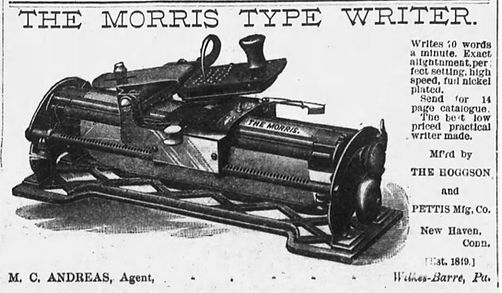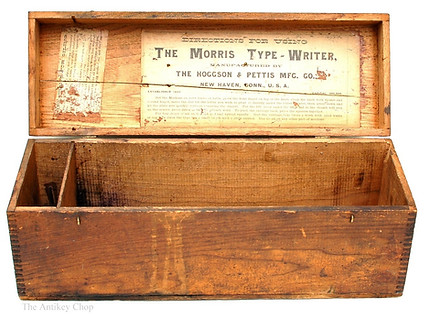
Morris
1885 - 1890
The Hoggson & Pettis Mfg. Co.
New Haven, Connecticut, U.S.
"The Morris Type-Writer," an index writing machine, was invented by Robert Erastus Morris (1848 - 1887) of Wichita, Kansas. Depending on how one decides to categorize this typewriter, there were either three models produced, Nos.1 - 3, or just two, Nos.1 & 2, and a pre-production model.



The earliest model, with its solid wood base (pictured above), is the one that could be referred to as the pre-production model. According to Adler's Antique Typewriters From Creed to QWERTY, the latter manufacturer of the Morris, The Hoggson & Pettis Manufacturing Company, offered two cast iron, lattice-based models, one with smaller type and another with larger, which the company clearly designated as the Nos.1 & 2 models. Though the original wood-base model did not have an official designation, it was made first.
Robert Morris applied for a patent for the Morris in 1885, which was awarded to him in 1887 (patent no.355,703). At about the same time that he'd applied, Robert began producing and selling the wood-based model. Then, in 1886, he sold the design to the Hoggson & Pettis. After making its modifications, also in 1886, the company began producing the Morris even though the typewriter's U.S. patent still hadn't been awarded. It was, however, already patented in England as of February, 1, 1886.

According to A Modern History of New Haven and Eastern New Haven County, Volume 1, published in 1918, the Hoggson & Pettis company "was established by S.J. Hoggson in 1849 and was made a company in 1878 with Mr. Pettis as a partner. It was incorporated in 1882." During the time that the company was manufacturing the Morris it was located at 68 Court Street in New Haven, Connecticut (the company later moved to 141 Brewery St.). It was listed in several directories as a typewriter manufacturer until 1890.
Typewriters weren't the only items that Hoggson & Pettis made. In fact, the Morris was probably one of the shortest lived and least successful of the company's products. Hoggson & Pettis also manufactured Sweetland lathe chucks, engraving rollers, ticket punches, pipe wrenches and all sorts of products for various industries. One other item of interest to collectors of office equipment is the Automatic Safety Punch, a check protector, that the company produced between 1887 and 1895.
Paul Lippman does a good job explaining how the Morris operates in his book, American Typewriters, A Collector's Encyclopedia. In it he illustrates that, "The Morris prints from a square plate of rubber type inked by a pad. To print, one moves the machine's index plate until the desired character is beneath a fixed pointer, then depresses the plate, which forces the rubber type through a hole in the ink pad. A stud on the underside of the index plate mates with a hole in a type guide to align the type."

The Morris had a fair U.S. distribution network (Kansas, Illinois, Pennsylvania, New York and others) and, to my surprise, it had a small foreign distribution presence as well. The two ads below both date to June of 1888. One is from a Canadian distributor and the other from The Netherlands. The Canadian ad at least has an image of the Morris, even if it is barely distinguishable. The Dutch ad simply mentions it by name, right above a solicitation for gymnastic equipment (turntoestellen).


The Hoggson & Pettis company sold the Morris for $15 dollars in U.S. markets. Advertisements proclaimed that that a proficient user could type up to 70 words per minute. The typewriter was capable of producing 45 different characters. Each Morris came with a wood case with paper label instructions glued to its inside lid. An oiling kit was also included which would have fit conveniently in a small compartment within the case.


The Morris was about one foot long and weighted just 4-1/4 lbs. The total weight of the typewriter and case was about 7 lbs.
Fun fact: The Morris was outfitted with a white rubber platen instead of the more traditional black.
The last of the ads for the Morris typewriter were published in 1890 and I assume production ceased at about the same time. Robert E. Morris died on Valentine's Day, 1897 of pneumonia. The building that currently stands at 68 Court Street in New Haven is not the same one in which the latter Morris models were manufactured.
See an original letter from Hoggson & Pettis with a Morris illustration on its reverse here...
Have a Morris Typewriter for sale? Please email me at Antikey.Chop@gmail.com or call +1 (860) 729-2252






